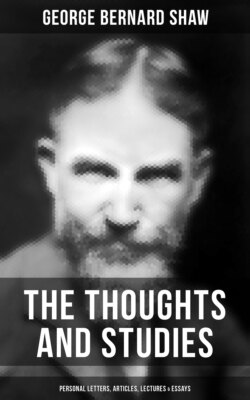Читать книгу The Thoughts and Studies of G. Bernard Shaw: Personal Letters, Articles, Lectures & Essays - George Bernard Shaw - Страница 54
На сайте Литреса книга снята с продажи.
BACK TO OPERA AGAIN
ОглавлениеTable of Contents
And now, O Nibelungen Spectator, pluck up; for all allegories come to an end somewhere; and the hour of your release from these explanations is at hand. The rest of what you are going to see is opera, and nothing but opera. Before many bars have been played, Siegfried and the wakened Brynhild, newly become tenor and soprano, will sing a concerted cadenza; plunge on from that to a magnificent love duet; and end with a precipitous allegro a capella, driven headlong to its end by the impetuous semiquaver triplets of the famous finales to the first act of Don Giovanni or the coda to the Leonore overture, with a specifically contrapuntal theme, points d’orgue, and a high C for the soprano all complete.
What is more, the work which follows, entitled Night Falls On The Gods, is a thorough grand opera. In it you shall see what you have so far missed, the opera chorus in full parade on the stage, not presuming to interfere with the prima donna as she sings her death song over the footlights. Nay, that chorus will have its own chance when it first appears, with a good roaring strain in C major, not, after all, so very different from, or at all less absurd than the choruses of courtiers in La Favorita or “Per te immenso giubilo” in Lucia. The harmony is no doubt a little developed, Wagner augmenting his fifths with a G sharp where Donizetti would have put his fingers in his ears and screamed for G natural. But it is an opera chorus all the same; and along with it we have theatrical grandiosities that recall Meyerbeer and Verdi: pezzi d’insieme for all the principals in a row, vengeful conjurations for trios of them, romantic death song for the tenor: in short, all manner of operatic conventions.
Now it is probable that some of us will have been so talked by the more superstitious Bayreuth pilgrims into regarding Die Gotterdammerung as the mighty climax to a mighty epic, more Wagnerian than all the other three sections put together, as not to dare notice this startling atavism, especially if we find the trio-conjurations more exhilarating than the metaphysical discourses of Wotan in the three true music dramas of The Ring. There is, however, no real atavism involved. Die Gotterdammerung, though the last of The Ring dramas in order of performance, was the first in order of conception and was indeed the root from which all the others sprang.
The history of the matter is as follows. All Wagner’s works prior to The Ring are operas. The last of them, Lohengrin, is perhaps the best known of modern operas. As performed in its entirety at Bayreuth, it is even more operatic than it appears at Covent Garden, because it happens that its most oldfashioned features, notably some of the big set concerted pieces for principals and chorus (pezzi d’insieme as I have called them above), are harder to perform than the more modern and characteristically Wagnerian sections, and for that reason were cut out in preparing the abbreviated fashionable version. Thus Lohengrin came upon the ordinary operatic stage as a more advanced departure from current operatic models than its composer had made it. Still, it is unmistakably an opera, with chorus, concerted pieces, grand finales, and a heroine who, if she does not sing florid variations with flute obbligato, is none the less a very perceptible prima donna. In everything but musical technique the change from Lohengrin to The Rhine Gold is quite revolutionary.
The explanation is that Night Falls On The Gods came in between them, although its music was not finished until twenty years after that of The Rhine Gold, and thus belongs to a later and more masterful phase of Wagner’s harmonic style. It first came into Wagner’s head as an opera to be entitled Siegfried’s Death, founded on the old Niblung Sagas, which offered to Wagner the same material for an effective theatrical tragedy as they did to Ibsen. Ibsen’s Vikings in Helgeland is, in kind, what Siegfried’s Death was originally intended to be: that is, a heroic piece for the theatre, without the metaphysical or allegorical complications of The Ring. Indeed, the ultimate catastrophe of the Saga cannot by any perversion of ingenuity be adapted to the perfectly clear allegorical design of The Rhine Gold, The Valkyries, and Siegfried.
